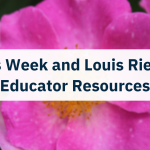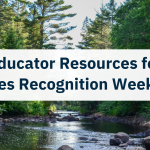Circles and Stories: How to Bring Oral Storytelling and Listening into the Classroom
Call to Action 62 of the Truth and Reconciliation Commission calls for teachers to “integrate Indigenous knowledge and teaching methods into classrooms.” One way of doing this is by centring oral storytelling and listening in our classrooms. Stories can help students understand their own experiences and place in the world. We can also use stories to teach important lessons. What would your teaching and curriculum look like with stories at the centre?
Storytelling Strategies
There are many ways storytelling can be used in the classroom. Approaching a new month or module with a storytelling focus can help create meaningful engagement for both teachers and students. Here are a few strategies and activities you can use with all grade levels:
- Centre storytelling in various artistic forms like drama, music, painting, and handwork. Consider using storytelling prompts to spark inspiration.
- Explore subjects like math, science, geography, and history through storytelling using biographies, traditional stories, and creating characters.
- Invite an Elder or community member to share a story with your class. Should you invite Elders or Knowledge Keepers into your classroom, students will also need guidance on the Protocols to follow and the use of honouring silence to show respect towards others. If you’re not familiar with the appropriate Protocols, reach out to your local Friendship Centre.
- Have students take turns reading a story — in whole or in part — to the whole class or smaller reading groups.
- Consider different themes and prompts for Show and Tell. Encourage the oral storytelling component of this activity.
- Prioritize oral presentations.
Listening
Learning to listen is an important part of oral storytelling in Indigenous communities. Kendal Netmaker, an entrepreneur, author, and speaker from Sweetgrass First Nation, shares that “[..] in Indigenous communities, the art of listening is not just a skill; it’s a way of life deeply ingrained in our cultural teachings.”
Learning to quiet oneself to receive what another has to share is an important skill for students to learn and practice at any age. Listening is the first step in committing something to memory and learning a story. It’s also a powerful opportunity for self-reflection. Listening is a subtle skill that guides the meaning-making of stories and encourages children to pay attention to non-verbal cues. Teaching students to listen in this way involves using their whole bodies.
Creating opportunities for students to practice meaningful listening can be done in a variety of ways. Here are a few activities that take on a new intention when the activity is focused on listening.
Listening Activities
- Bring your students to a quiet outside area and guide them to sit alone and quietly for 5 minutes. Ask your students to listen carefully to what they hear within themselves and around them. Facilitate a sharing circle to conclude this activity.
- Explore silent drawing, painting, and other forms of artwork. Guide your students to listen to the art they are creating. Is it loud? Quiet?
- Engage in Story Circles, where students must listen to what is said before them and then contribute one sentence to a collective story.
- Play Mystery Notes, where students close their eyes and listen to the number of notes played on an instrument (like a xylophone). With their eyes still closed, students count the notes and raise their fingers for each note they hear.
- Ask daily reflection questions, such as: How much time do you spend listening during the day? Who listens to you the best? Can you explain what they do to listen well? What is the hardest part about listening for you?
- Listen to audio recordings.
- Invite older students to record themselves sharing stories and play them for younger students.
- Centre listening as a daily, weekly, monthly, or annual theme.
Preparing the Space: Moving Desks and Making Circles
Gathering students in a circle when sharing stories and practicing listening is a small but powerful gesture. When students are seated in a circle, everyone is visible, equal, and connected. Dimming overhead lights, turning on smaller lamps, and placing meaningful objects at the centre of the circle are other ways to bring meaning and reverence to storytelling and listening. You can also host these circles outside.
Conclusion
As teachers, we can integrate Indigenous knowledge and teaching methods by centring oral storytelling and listening in our work with students. Bringing a few of the strategies and activities outlined in this article into your classroom can have a significant impact on your students. As Jo-Ann Archibald writes, “Stories can guide the development of our heart, mind, body, and spirit.” It is an exciting and fulfilling experience to work with our students in this way.








